12 Stunning Delphinium Varieties to Transform Your Garden
Published: October 25, 2025 at 4:20:57 PM UTC
Delphiniums are the aristocrats of the garden, creating dramatic spires of color that captivate with their majestic presence. These elegant perennials, with their towering flower stalks and vibrant blooms, have been garden favorites for generations. Whether you're drawn to classic blues and purples or seeking something more unusual, the perfect delphinium variety awaits to transform your garden into a breathtaking display.
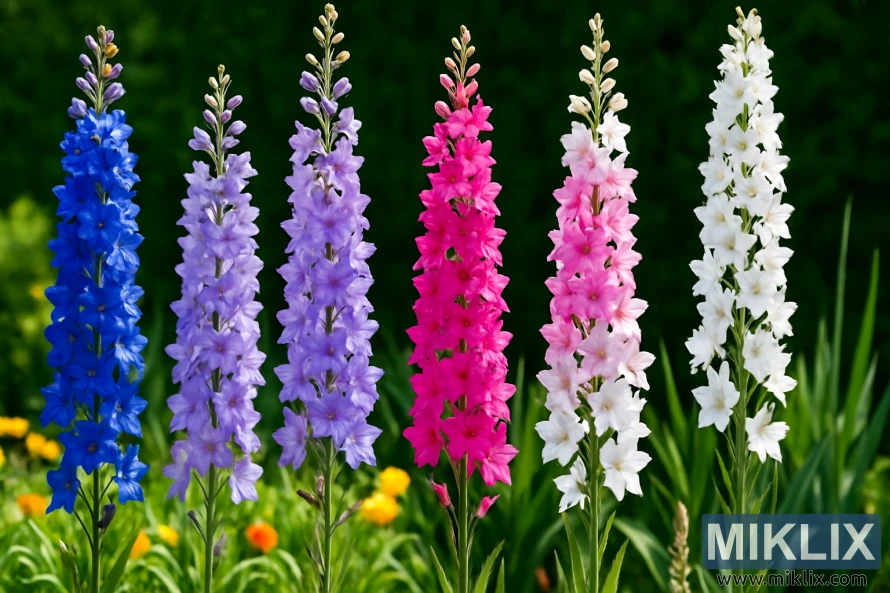
In this guide, we'll explore the most beautiful delphinium varieties and share expert tips to help you grow these stunning flowers successfully.
About Delphiniums: Garden Royalty
Delphiniums belong to the Ranunculaceae family and include approximately 300 species. These magnificent plants are known for their tall, stately flower spikes that create a dramatic vertical element in garden designs. The name "delphinium" comes from the Greek word for dolphin, referencing the shape of the flower buds.
Most garden delphiniums are cultivated from Delphinium elatum, though other species like D. grandiflorum and D. belladonna have also contributed to the development of modern varieties. These perennials typically bloom in early to midsummer, with some varieties offering a second flush of flowers in late summer if properly deadheaded.
What makes delphiniums truly special is not just their height—which can range from compact 12-inch varieties to towering 6-foot specimens—but also their extraordinary color palette. While they're famous for their true blues (a rare color in the garden), delphiniums also come in purples, pinks, whites, and even red and yellow shades. Many varieties feature a contrasting center called the "bee," which adds further visual interest.
Delphiniums are the closest to true blue that you'll find in the garden. Their majestic presence creates a vertical architecture that draws the eye upward and adds drama to any garden design.
Essential Growing Conditions for Delphiniums
Before we explore specific varieties, understanding the basic requirements for growing delphiniums will help ensure your success with these magnificent flowers:
Sunlight Requirements
Delphiniums thrive in full sun in cooler climates (6-8 hours daily). In warmer regions (Zones 7-8), they benefit from afternoon shade to protect them from intense heat.
Soil Conditions
These plants prefer rich, fertile soil with excellent drainage. They perform best in slightly alkaline to neutral soil (pH 6.5-7.5). Amend heavy clay soils with compost and sand to improve drainage.
Watering Needs
Consistent moisture is essential, especially during the growing season. Water deeply when the top inch of soil feels dry, but avoid waterlogged conditions which can lead to root rot.
Temperature Tolerance
Most delphiniums are hardy in USDA zones 3-7. They prefer cool summers and can struggle in hot, humid conditions. In warmer zones, choose heat-tolerant varieties and provide afternoon shade.
Support Requirements
Taller varieties need staking to prevent damage from wind and rain. Install stakes early in the season before plants reach 12 inches tall to avoid damaging the roots.
Fertilization
As heavy feeders, delphiniums benefit from regular fertilization. Apply a balanced slow-release fertilizer in spring and supplement with liquid fertilizer during the growing season.
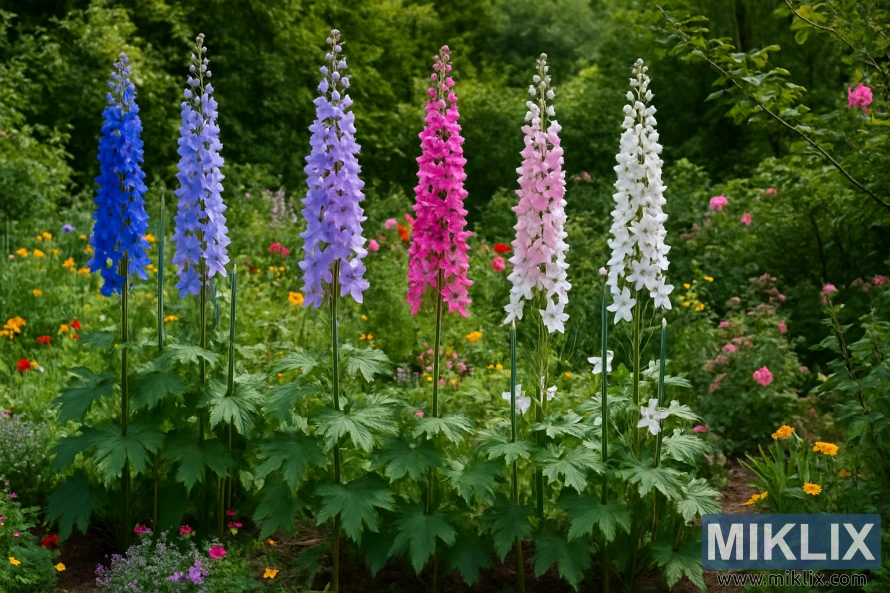
12 Magnificent Delphinium Varieties for Your Garden
Now let's explore some of the most beautiful delphinium varieties you can grow in your garden. Each has unique characteristics that make it special, from color and height to bloom time and growing requirements.
1. 'Black Knight' (Pacific Giant Hybrid)
- Botanical Name: Delphinium elatum 'Black Knight'
- Height/Spread: 5-6 feet tall, 2-3 feet wide
- Flower Color: Deep purple-blue with white or black bee
- Bloom Time: Early to midsummer, with possible rebloom
- Hardiness: USDA Zones 3-7
'Black Knight' is renowned for its intense, velvety purple-blue flowers that create a dramatic statement in the garden. This Pacific Giant hybrid produces tall, sturdy stems packed with semi-double blooms, making it perfect for the back of borders or as a focal point. The white or black bee at the center of each flower provides striking contrast against the deep-colored petals.
This variety requires staking due to its impressive height. Plant in a sheltered location to protect the tall flower spikes from strong winds. 'Black Knight' makes an excellent cut flower and attracts butterflies and hummingbirds to the garden.
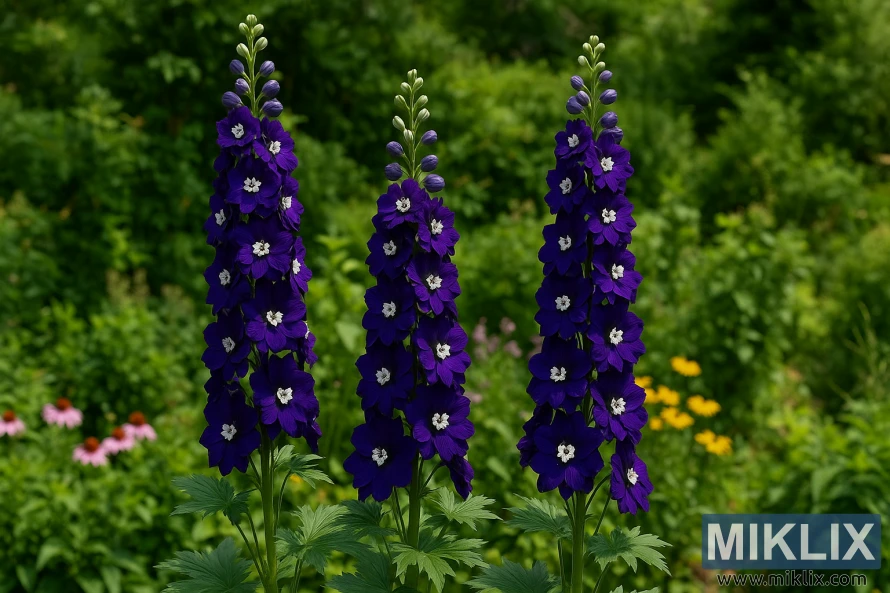
2. 'Galahad' (Pacific Giant Hybrid)
- Botanical Name: Delphinium elatum 'Galahad'
- Height/Spread: 4-6 feet tall, 2-3 feet wide
- Flower Color: Pure white with white bee
- Bloom Time: Early to midsummer
- Hardiness: USDA Zones 3-8
'Galahad' offers pristine white blooms that bring a touch of elegance to any garden. This classic variety features semi-double flowers with a white bee, creating a clean, monochromatic appearance. The pure white spires look particularly striking when planted against a dark background or when illuminated by moonlight in evening gardens.
Like other tall delphiniums, 'Galahad' benefits from protection against strong winds and requires staking. The white flowers can show damage more readily than colored varieties, so providing some shelter from heavy rain is beneficial. This variety pairs beautifully with blue delphiniums for a classic color combination.
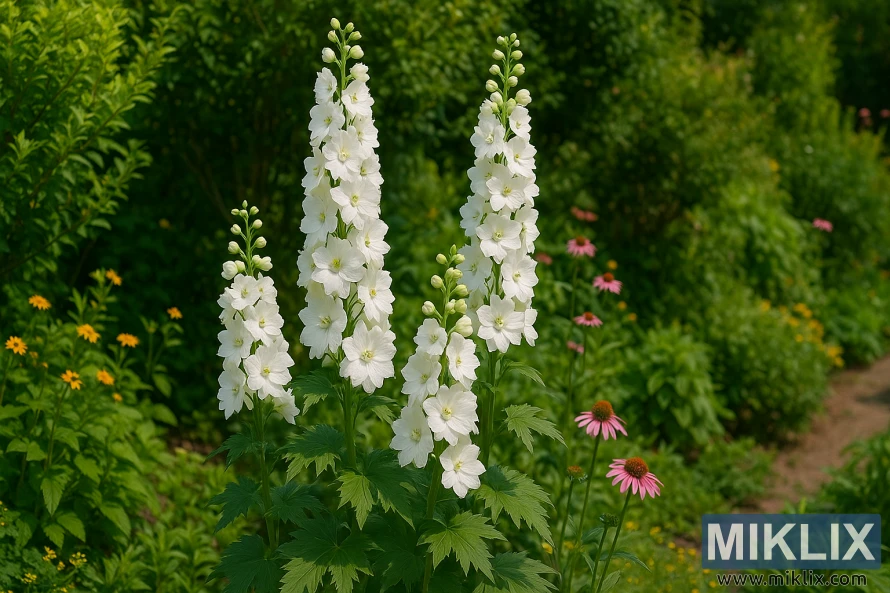
3. 'Guinevere' (Pacific Giant Hybrid)
- Botanical Name: Delphinium elatum 'Guinevere'
- Height/Spread: 4-6 feet tall, 2-3 feet wide
- Flower Color: Lavender-pink with white bee
- Bloom Time: Early to midsummer
- Hardiness: USDA Zones 3-8
'Guinevere' delights with its soft lavender-pink blooms that add a romantic touch to the garden. Part of the Arthurian-named series of Pacific Giant hybrids, this variety features semi-double flowers with a white bee. The delicate coloration makes it a perfect companion to both blue and white delphiniums.
This variety creates a stunning visual impact when planted in groups of three or more. For a striking contrast, pair 'Guinevere' with deep red roses or white flowers. Like other tall delphiniums, it requires staking and benefits from a sheltered location to protect its beautiful blooms.
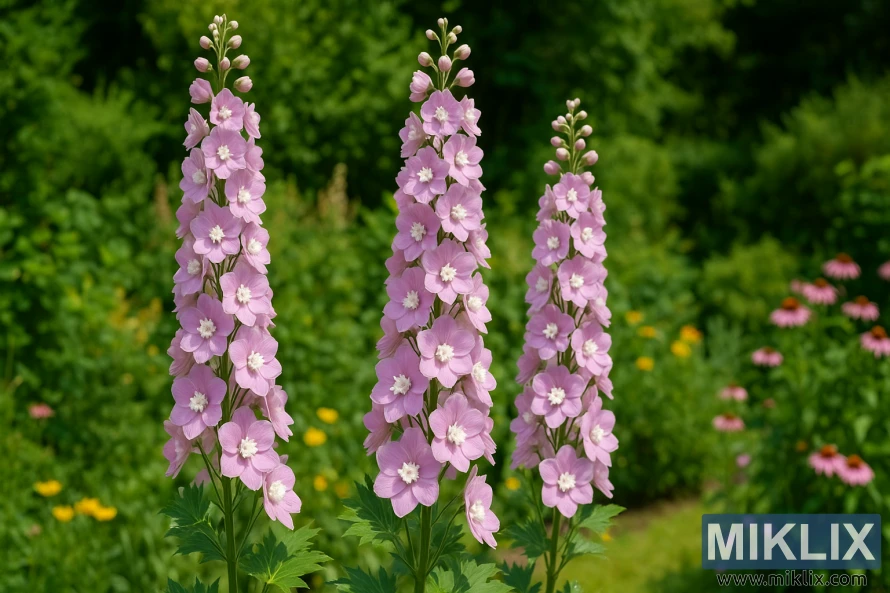
4. 'Blue Butterfly' (Chinese Delphinium)
- Botanical Name: Delphinium grandiflorum 'Blue Butterfly'
- Height/Spread: 12-18 inches tall, 12-18 inches wide
- Flower Color: Intense cobalt blue
- Bloom Time: Early summer to early fall
- Hardiness: USDA Zones 3-8
'Blue Butterfly' is a compact Chinese delphinium that differs from the tall spire-forming varieties. This charming plant features ferny foliage and masses of intense blue flowers that bloom over a long period. Its shorter stature makes it perfect for the front of borders, rock gardens, or containers.
Unlike taller delphiniums, 'Blue Butterfly' doesn't require staking and is more tolerant of heat and humidity. It's also more likely to rebloom if deadheaded regularly. This variety can be grown as a short-lived perennial or treated as an annual in warmer climates. Its true-blue flowers are rare in the garden world and make a striking addition to any planting scheme.
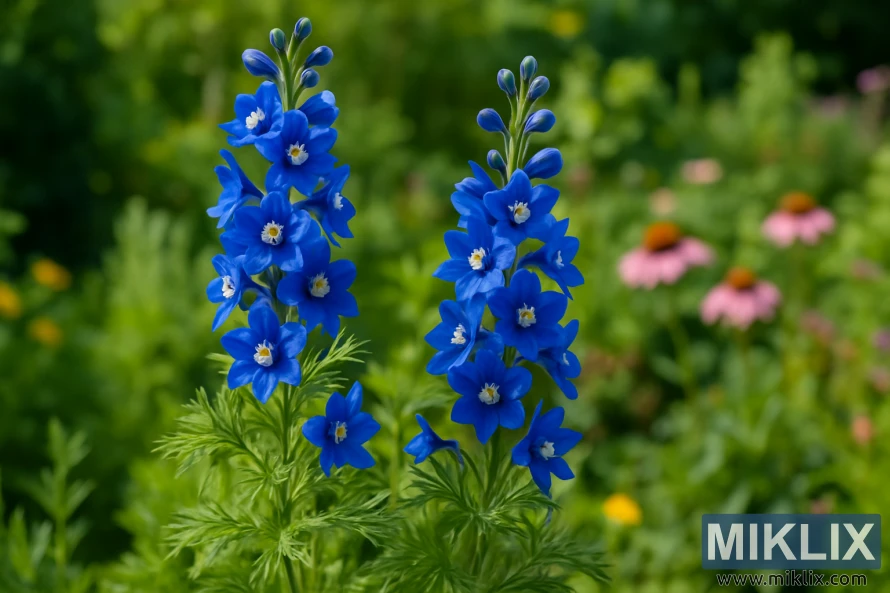
5. 'Cobalt Dreams' (New Millennium Series)
- Botanical Name: Delphinium 'Cobalt Dreams'
- Height/Spread: 4-6 feet tall, 2-3 feet wide
- Flower Color: True cobalt blue with white bee
- Bloom Time: Early to midsummer
- Hardiness: USDA Zones 3-7
'Cobalt Dreams' is a stunning New Zealand hybrid known for its true blue color—a rarity in the garden world. This variety features large, semi-double flowers with a striking white bee, creating a beautiful contrast against the intense blue petals. The strong stems hold up well in the garden, though staking is still recommended.
Developed as part of the New Millennium series, 'Cobalt Dreams' offers improved garden performance with stronger stems and better disease resistance than older varieties. Plant in groups for maximum impact, or use as a vertical accent in mixed borders. The vibrant blue color is visible from a distance, making it perfect for the back of garden beds.
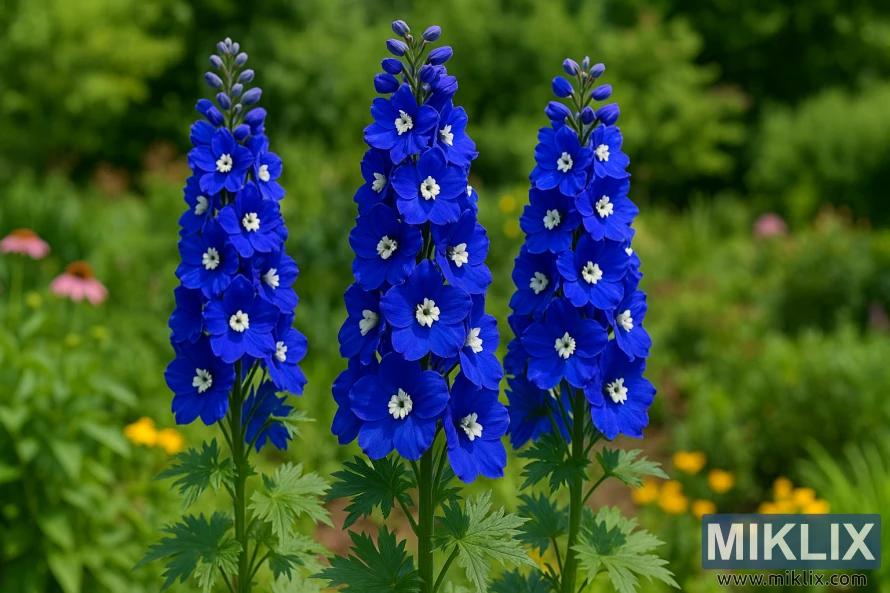
6. 'Summer Skies' (Pacific Giant Hybrid)
- Botanical Name: Delphinium elatum 'Summer Skies'
- Height/Spread: 4-6 feet tall, 2-3 feet wide
- Flower Color: Light sky blue with white bee
- Bloom Time: Early to midsummer
- Hardiness: USDA Zones 3-7
'Summer Skies' captures the essence of a perfect summer day with its soft, light blue flowers. This Pacific Giant hybrid features semi-double blooms with a white bee, creating a delicate, airy appearance. The color is reminiscent of a clear blue sky, bringing a sense of serenity to the garden.
This variety pairs beautifully with purple lavender or white flowers for a classic cottage garden look. Like other tall delphiniums, 'Summer Skies' requires staking and benefits from a location sheltered from strong winds. The light blue color is particularly effective when planted where it catches the morning or evening light.
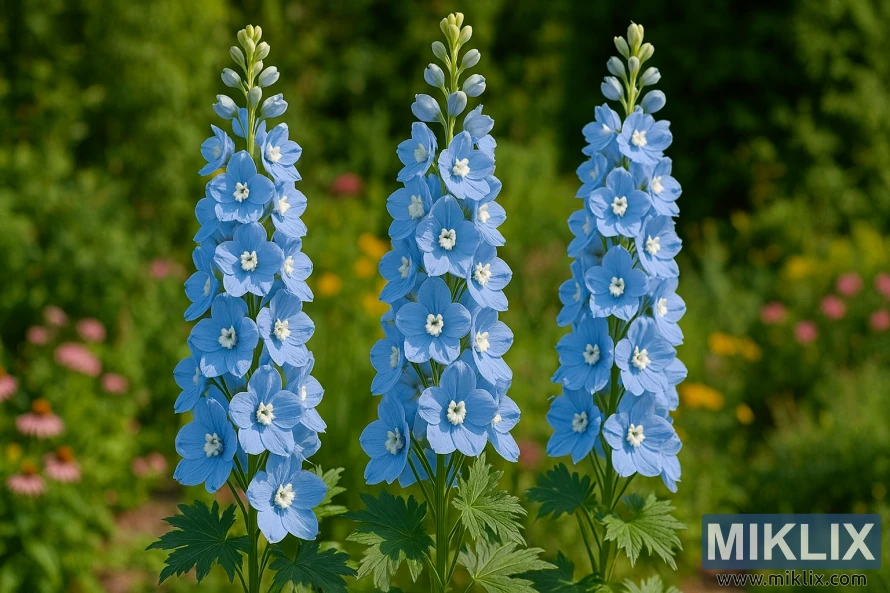
7. 'Princess Caroline' (Elatum Group)
- Botanical Name: Delphinium elatum 'Princess Caroline'
- Height/Spread: 2-3 feet tall, 1-2 feet wide
- Flower Color: Salmon-pink to coral
- Bloom Time: Early to midsummer
- Hardiness: USDA Zones 3-7
'Princess Caroline' offers a unique color break from traditional delphinium hues with its salmon-pink to coral flowers. This mid-sized variety features semi-double blooms that create a soft, romantic effect in the garden. Its more compact stature makes it suitable for smaller gardens or the middle of borders.
This variety makes an excellent cut flower and combines beautifully with blues and whites for a striking color contrast. Due to its shorter height, 'Princess Caroline' may not require staking in sheltered locations. For best results, cut back the foliage after the first bloom to encourage fresh growth and a potential second flowering.
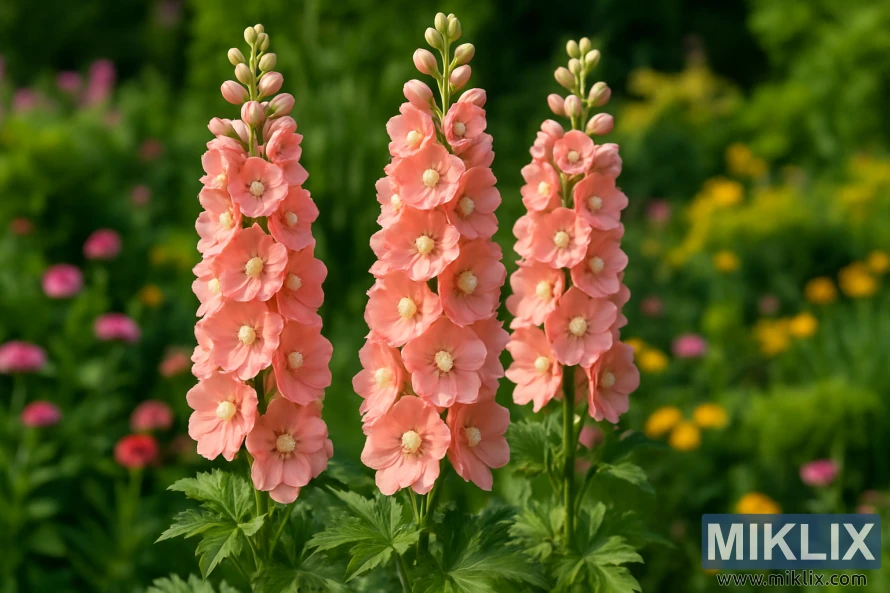
8. 'Magic Fountains White' (Magic Fountains Series)
- Botanical Name: Delphinium elatum 'Magic Fountains White'
- Height/Spread: 2-3 feet tall, 1-2 feet wide
- Flower Color: White with black bee
- Bloom Time: Early to midsummer
- Hardiness: USDA Zones 3-7
'Magic Fountains White' is a compact delphinium that packs a visual punch with its pure white flowers and striking black bee centers. This dwarf variety from the Magic Fountains series offers the classic delphinium look in a more manageable size, making it perfect for smaller gardens, containers, or the middle of borders.
The stark contrast between the white petals and black bee creates a dramatic effect that stands out in the garden. This variety rarely needs staking due to its shorter stature, making it easier to maintain than taller delphiniums. Try pairing it with dark-leaved plants or black flowers to emphasize the striking bee centers.
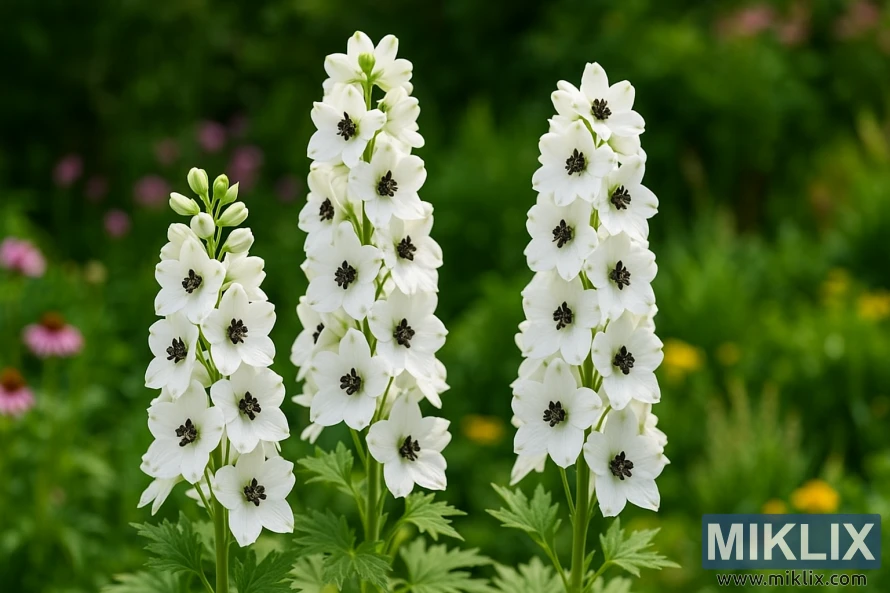
9. 'Highlander Flamenco' (Highlander Series)
- Botanical Name: Delphinium elatum 'Highlander Flamenco'
- Height/Spread: 3-4 feet tall, 1-2 feet wide
- Flower Color: Bicolor pink and raspberry
- Bloom Time: Early to midsummer
- Hardiness: USDA Zones 3-7
'Highlander Flamenco' is a show-stopping variety that breaks the mold with its unusual, fully double flowers. This Scottish-bred delphinium features ruffled, frilly blooms in shades of pink and raspberry that resemble small roses more than traditional delphinium flowers. The unique form adds textural interest to the garden.
Part of the Highlander series, 'Flamenco' grows to a medium height and produces sturdy stems that may still benefit from staking. The flowers are excellent for cutting and last well in arrangements. This variety makes a striking focal point in mixed borders and combines beautifully with silver-leaved plants for a sophisticated color scheme.
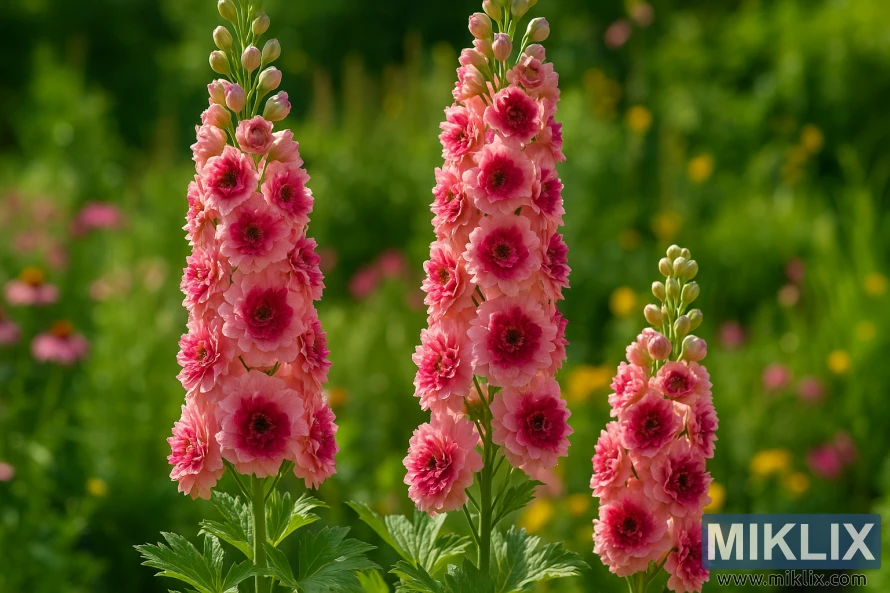
10. 'Aurora Lavender' (Aurora Series)
- Botanical Name: Delphinium elatum 'Aurora Lavender'
- Height/Spread: 3-4 feet tall, 1-2 feet wide
- Flower Color: Lavender-blue with white bee
- Bloom Time: Early to midsummer
- Hardiness: USDA Zones 3-7
'Aurora Lavender' is part of the Japanese-bred Aurora series, known for its uniform growth habit and sturdy stems. This variety features elegant lavender-blue flowers with a white bee, creating a soft, romantic effect in the garden. The smaller leaves make it particularly suitable for cutting and arranging.
At a medium height of 3-4 feet, 'Aurora Lavender' is more manageable than the tallest delphiniums while still providing vertical interest. The strong stems may not require staking in sheltered locations. This variety looks stunning when planted in groups and combines beautifully with roses and other cottage garden favorites.
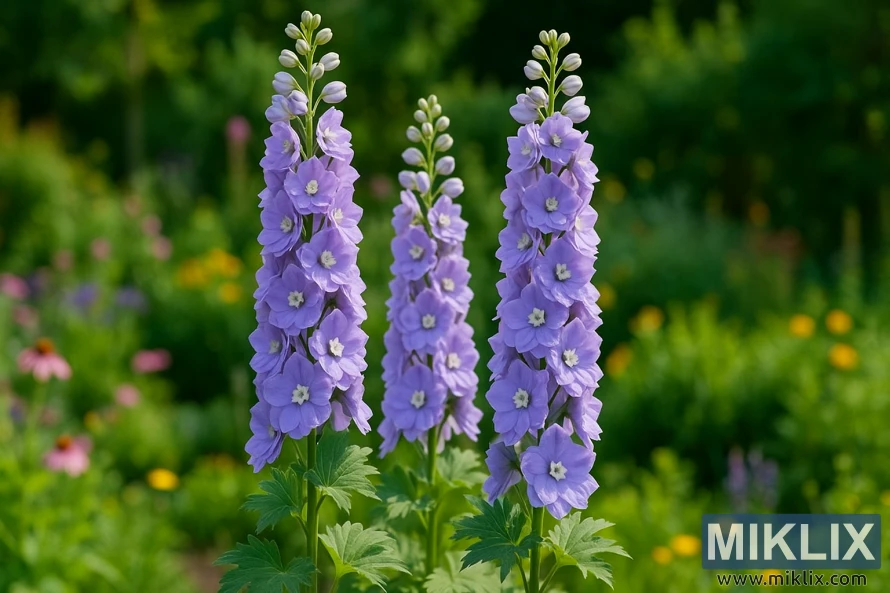
11. 'New Millennium Pink Punch' (New Millennium Series)
- Botanical Name: Delphinium 'Pink Punch'
- Height/Spread: 3-5 feet tall, 2-3 feet wide
- Flower Color: Rich burgundy-pink
- Bloom Time: Early to midsummer
- Hardiness: USDA Zones 3-7
'Pink Punch' is a standout variety from the New Zealand-bred New Millennium series, featuring unusually rich burgundy-pink flowers. This eye-catching delphinium produces large, semi-double blooms on strong stems, creating a bold statement in the garden. The unique color makes it a must-have for collectors.
Like other New Millennium hybrids, 'Pink Punch' offers improved garden performance with better heat tolerance and stronger stems than traditional varieties. However, staking is still recommended, especially in exposed locations. This variety makes excellent cut flowers and combines beautifully with silver-leaved plants and purple or blue companions.
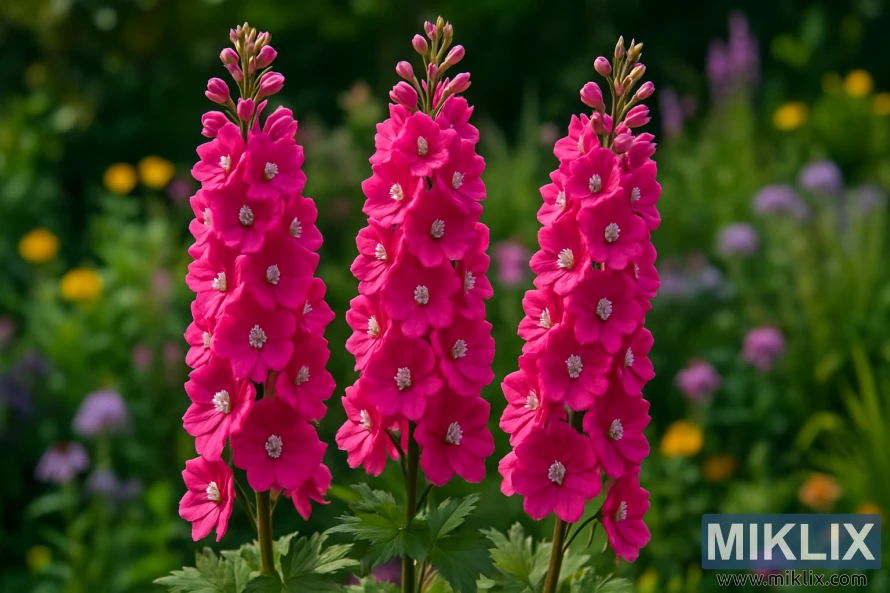
12. 'Delphina Dark Blue White Bee' (Delphina Series)
- Botanical Name: Delphinium elatum Delphina 'Dark Blue White Bee'
- Height/Spread: 14-18 inches tall, 12-16 inches wide
- Flower Color: Dark blue with white bee
- Bloom Time: Early summer to early fall
- Hardiness: USDA Zones 4-7
The Delphina series represents a breakthrough in delphinium breeding, offering compact plants that bloom the first year from seed. 'Dark Blue White Bee' features rich blue flowers with a clean white bee, creating a classic delphinium look in a container-friendly size. This dwarf variety is perfect for small gardens, pots, or the front of borders.
Unlike taller delphiniums, this compact variety doesn't require staking and is more tolerant of wind and rain. It also tends to rebloom more readily when deadheaded. The smaller size brings the intricate beauty of delphinium flowers closer to eye level, allowing gardeners to appreciate their detail. Try planting in containers near seating areas or pathways where their beauty can be enjoyed up close.
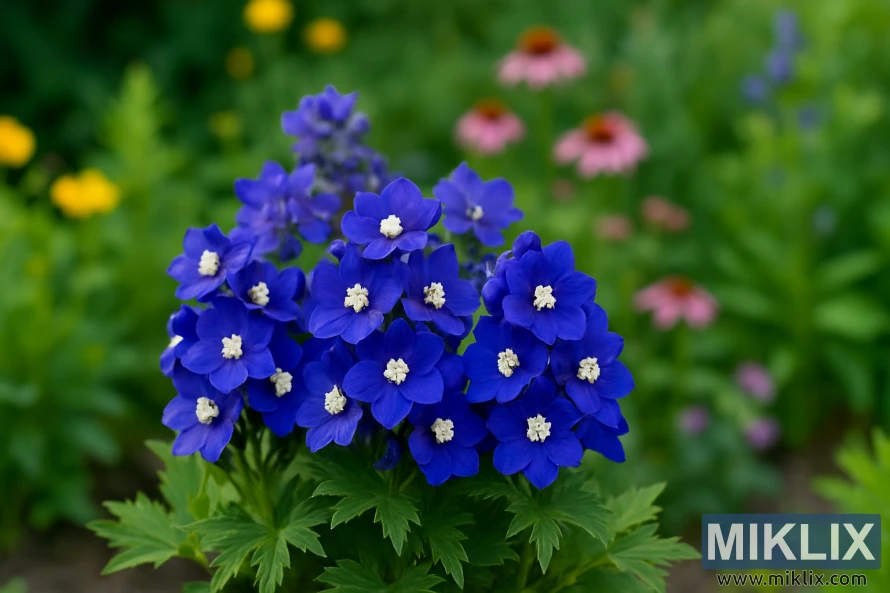
Essential Care Tips for Growing Magnificent Delphiniums
Planting
- Plant in spring or fall when temperatures are cool
- Space plants 2-3 feet apart to allow for good air circulation
- Plant at the same depth as they were in their nursery containers
- Add compost or well-rotted manure to the planting hole
- Water thoroughly after planting to settle soil around roots
Maintenance
- Deadhead spent flowers to encourage potential reblooming
- Cut flower stalks back to basal foliage after blooming
- Divide plants every 3-4 years in spring to maintain vigor
- Apply a layer of mulch to retain moisture and suppress weeds
- Protect from slugs and snails, especially in spring
Support
- Install stakes or supports when plants are 12 inches tall
- Use bamboo canes, metal stakes, or grow-through supports
- Secure stems with soft garden twine in a figure-eight pattern
- For tall varieties, use multiple ties along the stem
- Position plants in sheltered locations to reduce wind damage
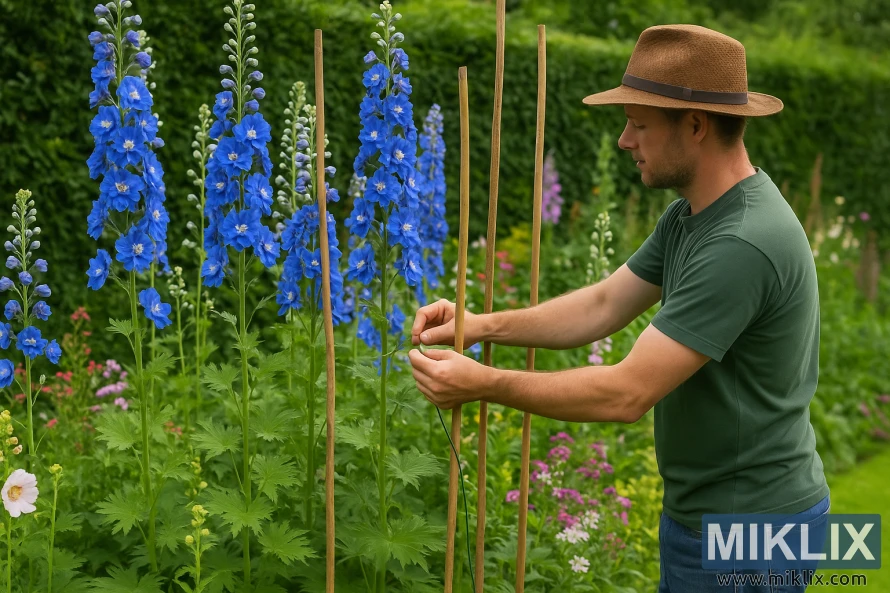
First-Year Flowering
For the healthiest delphiniums, allow first-year plants to produce only one flower spike. Remove additional spikes to help the plant establish a strong root system. In the second year, allow up to three spikes, and by the third year, up to five spikes. This gradual approach helps delphiniums develop strength and longevity.
Pest and Disease Management
Common Pests
- Slugs and Snails: Apply organic slug bait or create barriers with copper tape or diatomaceous earth
- Aphids: Spray with insecticidal soap or a strong stream of water
- Cyclamen Mites: Remove affected plant parts and apply insecticidal soap
- Leaf Miners: Remove and destroy affected leaves
Common Diseases
- Powdery Mildew: Improve air circulation and apply fungicide if necessary
- Crown Rot: Ensure good drainage and avoid overwatering
- Bacterial Spot: Remove affected leaves and avoid overhead watering
- Black Spot: Apply organic fungicide and improve air circulation
Design Ideas for Showcasing Delphinium Varieties
Delphiniums are versatile garden plants that can enhance various garden styles. Here are some creative ways to incorporate these magnificent flowers into your landscape:
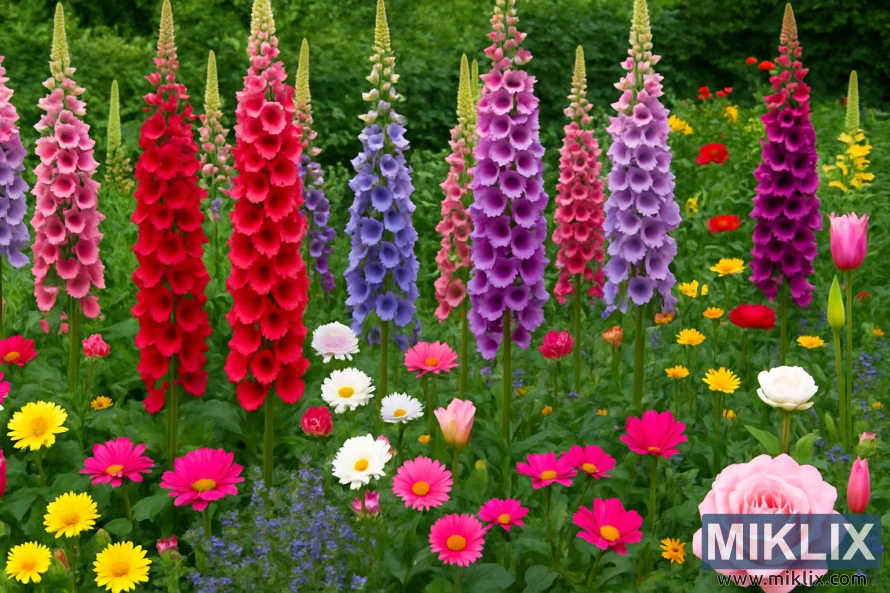
Cottage Garden Combinations
Delphiniums are quintessential cottage garden plants. Create a romantic, informal display by combining them with:
- Roses, especially in complementary colors
- Foxgloves for additional vertical interest
- Peonies for contrasting flower forms
- Lavender for texture and fragrance
- Shasta daisies for simple, clean contrast
Formal Garden Applications
The stately nature of delphiniums makes them suitable for more formal garden designs:
- Plant in symmetrical arrangements along pathways
- Create monochromatic blocks of single colors
- Use as vertical accents in knot gardens
- Combine with clipped boxwood for structure
- Plant in a row behind lower-growing perennials
Color Scheme Suggestions
Delphiniums offer opportunities for stunning color combinations:
- Classic Blue and White: Blue delphiniums with white roses or phlox
- Cool Pastels: Lavender and pink delphiniums with pale yellow companions
- Bold Contrast: Deep blue delphiniums with orange or yellow flowers
- Monochromatic: Various shades of blue delphiniums for a serene effect
- Sunset Tones: Pink and salmon delphiniums with bronze foliage plants
Container Gardening
Compact delphinium varieties work well in containers:
- Choose dwarf varieties like 'Blue Butterfly' or Delphina series
- Use large, deep containers (at least 12 inches deep)
- Ensure excellent drainage with holes and gravel at the bottom
- Combine with trailing plants for a balanced composition
- Position containers where they're protected from strong winds
Delphiniums create a sense of height and drama in the garden that few other perennials can match. Their vertical form draws the eye upward and adds architectural interest to any planting scheme.
Embrace the Majesty of Delphiniums in Your Garden
Delphiniums offer gardeners a unique combination of height, color, and elegance that few other perennials can match. From the towering Pacific Giant hybrids to the compact Delphina series, there's a delphinium variety to suit every garden style and size. Their true blue flowers are particularly precious in the garden world, where genuine blue is a rare commodity.
While delphiniums have a reputation for being somewhat demanding, the rewards they offer are well worth the effort. With proper care—including rich soil, consistent moisture, and appropriate support—these magnificent plants will return year after year to create a spectacular vertical display in your garden.
Whether you're drawn to the classic blue spires, elegant whites, or unusual pinks and purples, delphiniums bring a touch of majesty to any garden setting. Their versatility in design applications, from cottage gardens to containers, makes them indispensable plants for gardeners seeking to create visual impact and seasonal drama.
Further Reading
If you enjoyed this post, you may also like these suggestions:
- 15 Most Beautiful Flowers to Grow in Your Garden
- Most Beautiful Hydrangea Varieties to Grow in Your Garden
- A Guide to the Most Beautiful Tulip Varieties for Your Garden
